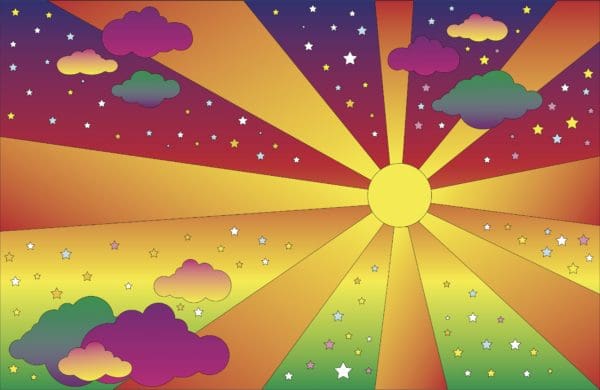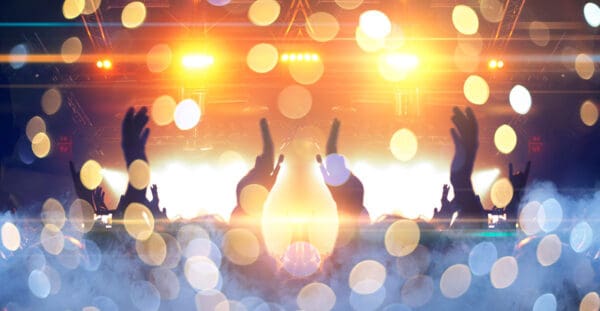In the 1960s, the counterculture movement became a catalyst for social change as a new generation stood in collective defiance to oppressive social institutions and the ego-driven mentality of the past. The effects of psychedelics significantly influenced the counterculture ideology, which was driven by empathy, unity, and demands for social change and an end to war.
Unsurprisingly, art and music from the time (called Psychedelia ) were impactful, revolutionary, and unlike anything the world had seen before. Visual artists openly discussed the influence of LSD on their art, in case it wasn’t already apparent from the electric array of colors, fantastical imagery, or text that appeared to bubble and melt.
Just as visual art from the 1960s remains unmistakably recognizable to this day, the music created during the era, produced by some of the most iconic artists in history, was called psychedelic rock, and it changed music forever. Distortion, trippy effects, and fragmented sequences were new and radical diversions from the status quo, but what sounded like disregard for the aesthetic value of music was anything but.
The eclectic effects and changes in rhythm, timing, and tone had specific intentions of evoking the mystical experience of an LSD trip. What emerged might have seemed to music purists like madness; however, the sonic sacrilege was intentional. The legacy of psychedelic rock is undeniable. It redefined music in an everlasting way.
This philosophy is attributed to psychedelic rock’s namesake and the technicolor history that shaped everything we love about rock today.
History of psychedelic rock
Psychedelic rock emerged in the 1960s, and the eclectic sounds resonated with those individuals in the counterculture movement who shocked their parents with disregard for convention. Popular music mirrored what the movement stood for in creative and personal freedom, exploring higher consciousness and connectedness, and opposition to the Vietnam War. Unprecedented events like the Human Be-In (during the Summer of Love in 1967) and Woodstock (1969) helped drive the popularity of artists associated with the genre.
The 13th Floor Elevators were the first group known to define their style as psychedelic rock, but many more emerged and followed suit amidst a widespread embrace of the term. Names like Pink Floyd, The Doors, The Grateful Dead, Jefferson Airplane, Jimi Hendrix, The Beatles, The Rolling Stones, and The Yardbirds are immortalized by their astounding popularity throughout the era and remain best-selling artists to this day.
The genre faded from the landscape of popular music for a while after psychedelics became illegal. The War on Drugs established severe legal consequences for the use of these mind-altering substances. However, the legacy and influence is evidenced by the emergence of progressive or “prog” rock and heavy metal in the years that followed, as well as the revolutionary use of distortion and effects that changed the rock genre forever.
Psychedelic rock has reemerged in recent years with undeniable tributes paid to the original sounds and stylistic elements birthed from the 1960s counterculture era. The Flaming Lips, Thee Oh Sees, Ty Segal, The Black Angels, and Tame Impala are some of the most recognizable names and represent the sonic diversity within the psychedelic rock genre.
What is psychedelic rock?
Psychedelic rock is unique because it does not subscribe to a specific sound. Instead, the commonality lies primarily in its intent to evoke or inspire a psychedelic experience by offering a sonic representation of the artists’ own experiences in this realm. Psychedelic rock is a remarkable concept, employing sound to illustrate the nature of mystical experiences to bring them to life.
Although the criteria for music to be called psychedelic is fluid and often refers to its influences more than the sound and style itself, there still tends to be some common characteristics. Heavy reverberation, distortion, and effects mimic changes in perception, while changes in rhythm or speed and chord progression illustrate the altered sense of time during a psychedelic experience.
In his book Sixties Rock: Garage, Psychedelic, and Other Satisfactions, Michael Hicks describes the psychedelic rock genre as a sonic representation and evocation of 3 common experiential effects of LSD: depersonalization, dechronicization, and dynamization.
Depersonalization is a detachment from the sense of self (also called the ego) that drives the first-person narrative and self-referential perspective. Psychedelics temporarily dismantle the ego, which often hinders feelings of unity with the universe as a connected whole.
The intense volume and rhythmic repetition in some examples of psychedelic rock tend to draw the listener in, facilitate a trance-like state, and silence the distracting demands of the ego. This is, perhaps, one of the most hypnotic and immersive elements of certain styles within the genre.
Dechronicization is a perceived detachment from the constraints of time, which is common during a psychedelic experience. Changes in the perception of time can cause a reevaluation of its meaning and value.
The unexpected chord changes or shifts in timing, rhythm, and speed capture the essence of dechronicization. Prolonged and repetitive sequences may cause the listener to lose track of time as they mingle with improvised solos, slowly building up to a climactic ending.
Dynamization is best described in this context by Timothy Leary, who was a clinical psychologist at Harvard and advocated for psychedelics in his research career. He said that fixtures in the environment appear to dissipate or become weightless, becoming “moving, dancing structures.”
Music and psychedelic rock’s flagship trip: LSD
It goes without saying that LSD influenced psychedelic rock. Now, here’s a far-out question: if LSD influences the way we experience and relate to music, could music have an impact on how LSD interacts with the brain while we listen? Apparently, it does.
Though it isn’t known precisely how or why, researchers at Imperial College London observed music working synergistically with LSD during psychedelic-assisted therapy sessions. FMRI scans indicated that LSD facilitated imagery, emotions, and thoughts that could be beneficial to the therapeutic intent.
LSD has a steering effect on mental imagery when influenced by music, as evidenced by scans of the parahippocampal cortex (PHC) in the brains of study participants who listened to music with their eyes closed after LSD was administered. The PHC plays a key role in the emotional response to music as well as mental imagery and the activity of psychedelics. The study results demonstrated increased functional connectivity in the PHC-visual cortex (VC) and greater information flow from PHC to VC (as opposed to a placebo-controlled session when participants listened to music without LSD).
Serotonin 2A (5-HT2A) is a neurotransmitter known to affect music listening; its receptors are active in parts of the brain associated with processing music and emotional responses and perception. 5-HT2A signal activity was observed changing in correlation with dynamic changes in music, increasing the level of emotional response, perception of meaning, and connection. LSD appears to stimulate 5-HT2A receptors, which could explain the increases in emotion, perceived meaning, and feelings of connectedness that occur in response to music during a trip.
Learn more on Psychable
To learn more about LSD and find other articles about the creative influence of psychedelics, check out Psychable’s Culture resources.









